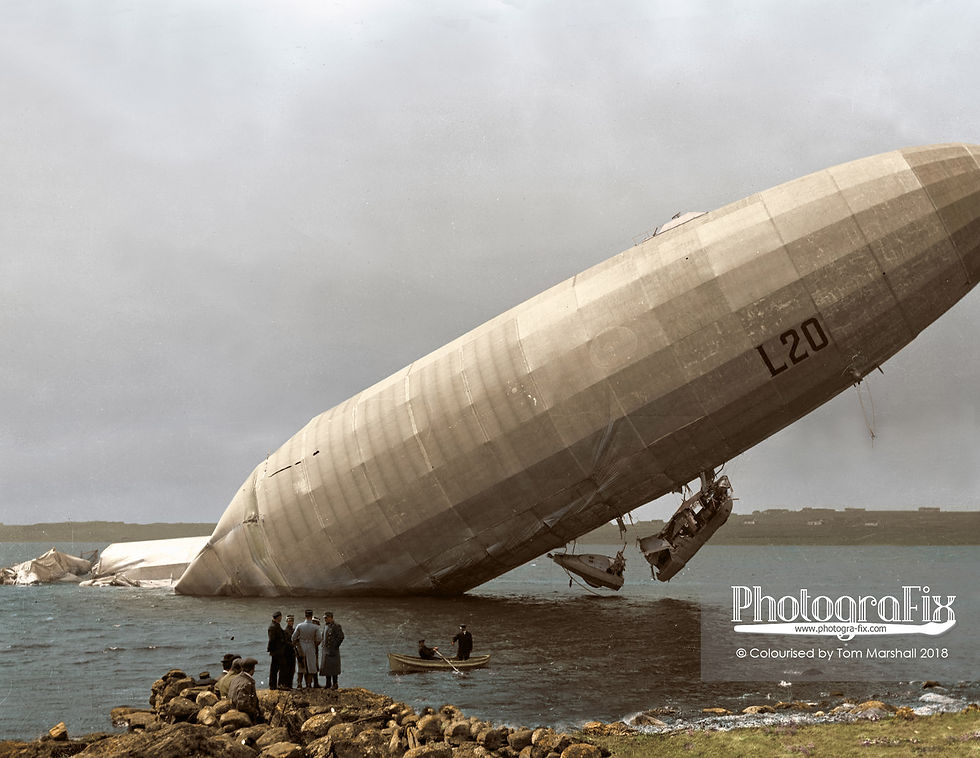
They were the height of luxury travel before the war, but nobody imagined the death and destruction that airships could bring to Britain's streets during World War One.

Damage in the yard of the home of vet and blacksmith Mr T.H. Walden in East Street off Albert Street, King’s Lynn, following a Zeppelin raid which took place on 19th January 1915. Despite the huge amount of damage caused by the bomb, the whole family - mother, father and three children - escaped with their lives.
Next door, however, three of the four occupants suffered injury but only one needed hospital treatment. Thank you to Ian Castle, author of ‘Zeppelin Onslaught’ for the above information. Original photo by H.D. Girdwood, courtesy of the British Library.
German Zeppelin airships began to attack English towns on the night of 19th January 1915, resulting in the first British civilian casualties of the war.
Approximately 4,800 British civilians were killed or wounded as a result of German air raids from 1914 to 1918 and the attacks on defenseless children in particular led the Zeppelins to be nicknamed 'baby killers' by the British public.
One of the worst raids took place on 13th June 1917, when 162 people were killed in London.

Soldiers inspect a garden and destroyed cherry tree, following a raid on Colchester on 21st February 1915. The bomb landed in the back garden of 41 Butt Road, the home of Quartermaster-Sergeant Rabjohn of 20th Hussars and his family. Rabjohn, his wife and their child escaped injury. Thank you to Ian Castle, author of ‘Zeppelin Onslaught’ for the above information. Original photo by H.D. Girdwood, courtesy of the British Library.
Zeppelins were like no other weapon ever encountered before. They were almost impossible to spot in the night sky, they flew higher than any British aeroplanes could reach, and were out of range of any guns, making them almost impossible to destroy, and terrifying the citizens of English towns and cities.

This is from the first Zeppelin raid on Britain, which took place on 19th January 1915. Two Zeppelins appeared over East Anglia. Zeppelin L 3 bombed Great Yarmouth and later Zeppelin L 4 appeared over King’s Lynn. This photo is reported to show Mr Fayers who lived at 11 Bentinck Street, King’s Lynn. A bomb exploded on 12 Bentinck Street, killing 14-year-old Percy Goate. His parents and 4-year-old sister survived.
Next door at No. 11, Mr and Mrs Fayers had spent the evening with Alice Gazley who lived nearby. When they heard explosions, Alice ran out of No. 11 and was killed; although buried in the rubble, Mr and Mrs Fayers sustained only minor injuries, Mr Fayers was ‘cut on head’. Thank you to Ian Castle, author of ‘Zeppelin Onslaught’ for the above information. Original photo by H.D. Girdwood, courtesy of the British Library.
These photos of Zeppelin and aeroplane damage were taken by Charles Hilton DeWitt Girdwood in 1915, and the original photos are now held by the British Library.

Soldiers inspect damage following a raid made by a single German aeroplane on Colchester on 21st February 1915. Thank you to Ian Castle, author of ‘Zeppelin Onslaught’ for the above information. Original photo by H.D. Girdwood, courtesy of the British Library.
The airship pictured below is the LZ 59 (bombing code L20). Zeppelin L20 was known as the ‘Raider of Loughborough’ after her part in an attack on the English Midlands.
On 31st January 1916, nine airships, including L20 left Germany and Denmark in order to attack the docks at Liverpool, which would have shocked the British public due to the long range of the attack.
The airships never reached Liverpool and, due to a miscalculation, instead dropped their bombs on several towns including Tipton, Wednesbury, Walsall, Burton upon Trent, Nottingham, Derby, and Loughborough.
L20 killed an estimated 10 people in Loughborough including Mary Anne Page and two of her children, whose names can be seen on a plaque in Loughborough Carillon Park.

On 2nd May 1916, L20 began its second bombing raid on Britain with the intention of attacking factories and railways in Middlesborough, Stockton-on-Tees and Hartlepool, and targeting enemy warships near Edinburgh.
However, engine problems and strong winds led the airship to veer off course. High winds blew her out into the North Sea and to neutral Norway where she crash landed into Hafrsfjord near Stavanger. The photo above is by Hans Henriksen / Stavanger City Archive.
Colourised images © Tom Marshall (PhotograFix) 2018
Original images by H. D. Girdwood - Source The British Library
Original image of L20 crash by Hans Henriksen / Stavanger City Archive.
Thank you to Ian Castle, author of ‘Zeppelin Onslaught’ for much of the above information
Prints are available to purchase here.
Tom Marshall is a British photo colouriser. Please visit my pages on Facebook, Twitter and Instagram.

